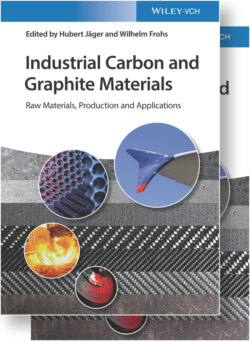Читать книгу Industrial Carbon and Graphite Materials - Группа авторов - Страница 21
2.4 Non‐graphitic Carbon
ОглавлениеNon‐graphitic carbons are all varieties of solids consisting mainly of the element carbon with two‐dimensional long‐range order of the carbon atoms in planar hexagonal networks, but without any measurable crystallographic order in the third direction (c‐direction) apart from more or less parallel stacking [16]. Only non‐graphitic carbons which have passed during thermal degradation (pyrolysis) a liquid or gaseous phase can be transformed by heat treatment (>2500 K) into synthetic graphite. Carbon‐containing substances that remain solid during thermal degradation remain non‐graphitic carbons even after heat treatments beyond 2500 K. They are so‐called non‐graphitizable carbons. One way to transform non‐graphitizable carbons into synthetic graphite is catalytic graphitization. This term is somewhat misleading as in most cases it is a precipitation of carbon dissolved in oversaturated metal melts. The most known catalytic graphite is the so‐called kish graphite, a precipitate from oversaturated iron melts, a well‐known phenomenon in the steel industry. Some more detailed information can be taken from [17].
